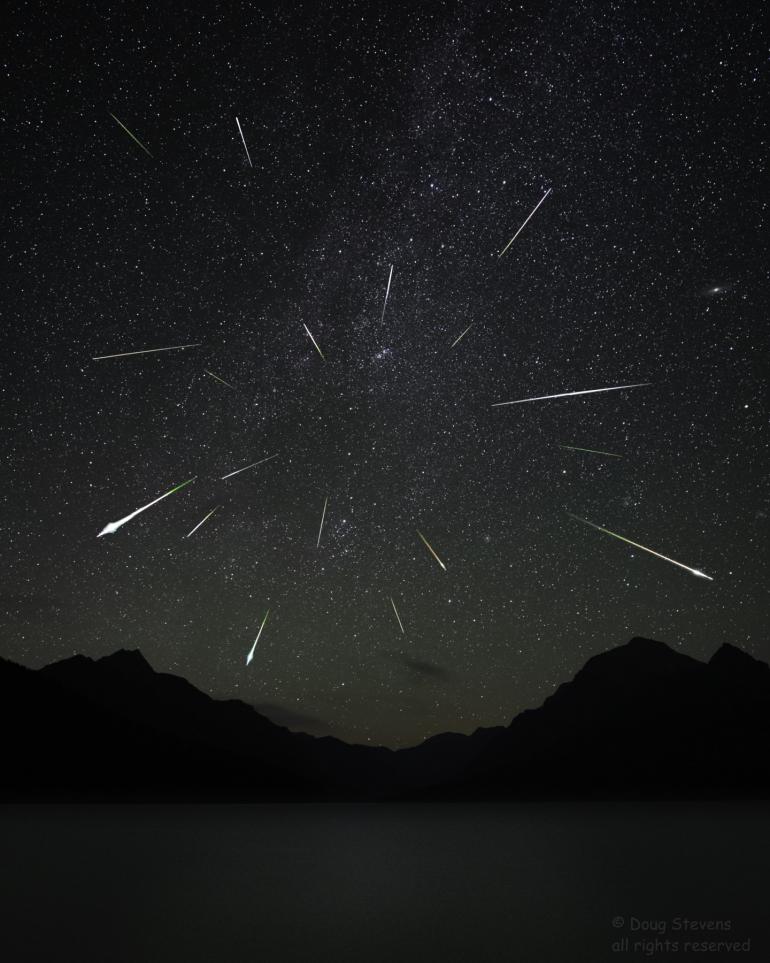Patience and the Perseids

How many kids every year lay down on warm, moonless summer nights and stare up at the starry sky in all its vastness, their imaginations captivated by what might be out there? And how excited are they when they see a "shooting star"? That was me as a kid, and I have been fascinated by the night sky ever since. I'm a sucker when it comes to a meteor shower – often sleeping outside in hopes of seeing a good display. As I have progressed with my photography over the years, I have really enjoyed getting back to my roots – the nighttime. The dark skies that much of Montana offers are great for this pursuit, such as photographing the Milky Way and last year's comet, Neowise. However, photographing a meteor shower was still on my bucket list.
There are meteor showers year-round as the Earth passes through the debris trails of various comets – some more active than others. To the observer on the ground, the streaking paths of these meteors seem to emanate from a common area of the sky. That particular area is known as the "radiant", and will be associated with a particular constellation where it is found. That's why meteor showers are named after constellations, like Perseus.
Some of the more impressive meteor showers are in the winter when we here in western Montana are unfortunately under clouds for much of the time. The highlight of the summer is the Perseids, which occur every year around the middle of August.
To observe and photograph meteor showers, you need three simple things: clear skies, no bright moon, and, as it turns out, lots of patience. For the Perseids, there is usually a full or near full moon every other year, which washes out the shower. This year, however, the peak occurred near the new moon, assuring dark skies for great viewing. Lately, though, our Montana "Big Sky" has been plagued by wildfire smoke from California, Oregon, Washington, British Columbia and Idaho. We seem to be downwind of fires every year now, and the smoke just funnels into Montana, whether we have large, active fires or not.
Clear August night skies are a bit of uncertainty these days. This makes any photography a real challenge, but especially night photography.
I admit I was not very optimistic about having clear skies for this year's Perseids.

With a near full moon on tap for 2022, it looked like I was going to have to wait until 2023 before I could try to photograph these again. As the peak time approached, though, patience paid off - the weather report changed to include a fast front clipping Glacier Park. Winds would switch to the northeast and blow the smoke out, at least for one night. Knowing the meteor shower would be in the northeast, I checked my map of Glacier and found three accessible lakes that actually faced that direction - McDonald, Bowman, and Kintla. Bowman has long been a favorite of mine, so I loaded up the camper and headed out.
After securing a campsite and a quick dinner, I set up on the pebble beach at Bowman.
Right on cue, the wind shifted and blew much of the haze out. I wasn't sure when the peak time would be, so I set my camera up to take continuous 15 sec exposures from about 11:30 until 3:30 am, when I started falling asleep at my post. As I sat there by my camera for 4 hours, I was disappointed at not seeing much in the way of significant meteors. It definitely wasn't living up to its "100 meteors per hour" predictions. Maybe I could have recorded a few more if I had let my camera carry on for another hour or so. However, the eastern horizon was beginning to take on some light, so I figured it was time to quit and go back to camp to take a short nap and wait for 2023.
In the end, I took over 1,000 exposures, and having nodded off a few times, I wasn't really sure just what I would see when I downloaded my camera files. When I loaded them onto my computer, hundreds of frames showed no meteors, confirming my suspicions in the field. I did notice many very small meteors – probably invisible to the naked eye, but not many of the long, explosive trails that the Perseids are known for. There were a few nice traces, some with green in their tails from ionizing the oxygen as they fell. There were also some smaller ones, too, so that in the end, it all made up for a reasonable photo and worth the effort.
Compared to taking normal, instant, daylight landscape photos of mountains, rivers, etc., photographing meteor showers can sure be an exercise in patience. Some may become bored just sitting on the shore of a beautiful lake at night for 4 hours doing essentially nothing but staring out at the sky. Not me – I am that kid again staring up into space and captivated by this incredible, infinite Creation. How can you be bored when we live in a state that sheds such beauty at all times, day or night? There is always more to take in.
As for the next Perseid shower? I'll be patiently waiting until 2023! In the meantime, click on the image below to inspect the details!
